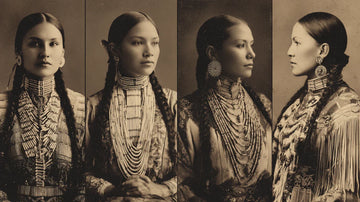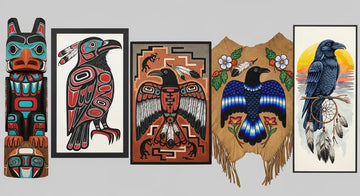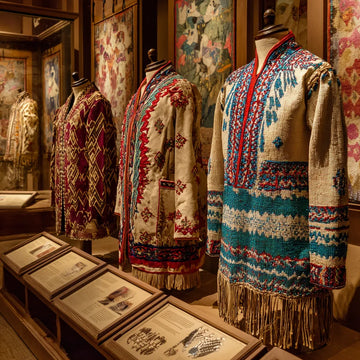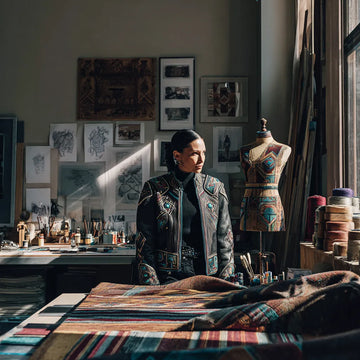Celebrating the profound cultural significance, intricate craftsmanship, and enduring legacy of indigenous women's traditional dress across Native American tribes
The traditional clothing of Native American women represents far more than mere garments – these sacred pieces embody centuries of cultural wisdom, spiritual significance, and artistic mastery. From the intricately beaded Plains dresses that could weigh up to sixteen pounds to the symbolic ribbon skirts that connect wearers to Mother Earth, each piece of Native American women's traditional clothing tells a story of resilience, identity, and profound cultural heritage.

Before European contact, indigenous women across North America created stunning garments using materials gifted by the natural world. Deer and elk hides formed the foundation of dresses, while buffalo hide provided warmth and protection. These materials were transformed through skilled hands into works of art, decorated with porcupine quills, animal teeth, bird claws, and natural dyes derived from minerals, clay, and plants. Every element was chosen with reverence, reflecting the deep spiritual connection between Native peoples and their environment.
The Majestic Plains Dress: Canvas of Cultural Expression
The Plains dress stands as perhaps the most recognizable form of traditional Native American women's clothing, serving as a canvas upon which indigenous women expressed their creativity, marked significant life events, and displayed family pride. These magnificent garments, typically crafted from three elk hides, represented the pinnacle of indigenous craftsmanship and cultural storytelling.
Cultural Significance
- Marriage celebrations and ceremonies
- Honoring family military service
- Tribal identity and clan affiliation
- Spiritual connection to ancestors
Craftsmanship Details
- Average weight: 13-16 pounds
- Thousands of glass seed beads
- Months of meticulous handwork
- Geometric patterns with deep meaning
During the reservation period (1880-1920), when time for sedentary activities became more plentiful, Native American women created dresses with massive beaded areas. These "best dresses" were reserved for the most special occasions, transforming the wearer into a living piece of art that honored both individual achievement and collective cultural identity.The Language of Beads: Patterns, Meanings, and Mastery

Native American beadwork represents one of the most sophisticated forms of indigenous artistic expression, with each pattern carrying deep spiritual and cultural significance. Before European contact, Native women used flattened and dyed porcupine quills to create intricate designs. The introduction of glass seed beads in the early 1800s revolutionized this art form, allowing for even more detailed and colorful expressions of cultural identity.
Geometric Patterns
- Diamond, triangle, and step patterns often represent mountains, water, or celestial bodies, connecting the wearer to the natural world.
Color Symbolism
- Each color holds specific meaning – red for strength, blue for wisdom, yellow for guidance, and white for purity and spiritual connection.
Regional Variations
- Plains tribes favored bold geometric designs, while Woodland peoples incorporated floral motifs influenced by their forest environments.
The mastery of beadwork was traditionally passed down from grandmother to mother to daughter, creating an unbroken chain of cultural knowledge and artistic skill. These techniques required not only artistic vision but also incredible patience and precision – a single dress might contain thousands of individually placed beads, each one contributing to the overall narrative of the garment. Today, you can find beautifully crafted pieces that honor these traditions in our jackets collection, where contemporary artisans continue this sacred art form.The Sacred Ribbon Skirt: Symbol of Feminine Power and Resilience
The ribbon skirt holds a special place in the hearts of Native American women across all tribes, representing womanhood, strength, and connection to Mother Earth. More than just clothing, the ribbon skirt has become a powerful symbol of cultural reclamation and indigenous pride, worn with honor at powwows, ceremonies, and in daily life as a declaration of identity.
"The ribbon skirt represents a symbol of womanhood. It is an identifying piece that connects you to the earth and Grandmother moon."

Spiritual Significance
The ribbon skirt serves as a spiritual garment that connects the wearer to ancestral wisdom and feminine power. The flowing ribbons are said to represent the movement of water, wind, and the sacred energy that flows through all living things.
Many women choose ribbon colors that hold personal meaning – honoring lost family members, celebrating achievements, or representing their clan affiliations. The act of wearing a ribbon skirt is itself a form of prayer and cultural affirmation.
Modern Relevance
Today's ribbon skirt represents cultural resilience and the reclamation of indigenous identity. It has become a symbol of solidarity among all Native tribes, transcending traditional boundaries to unite indigenous women in shared pride and strength.
The ribbon skirt also serves as a powerful reminder of missing and murdered indigenous women, with many choosing to wear specific colors to honor their memory and call for justice.
Sacred Materials and Time-Honored Techniques
The creation of traditional Native American women's clothing involves a deep understanding of natural materials and their spiritual significance. Each element is chosen not only for its practical properties but also for its connection to the natural world and the stories it can tell.
Traditional Materials
- Deer and Elk Hide: Soft, flexible foundation for dresses and skirts
- Buffalo Hide: Durable material for winter clothing and ceremonial robes
- Porcupine Quills: Natural decorative elements before glass beads
- Natural Dyes: Colors from berries, roots, and minerals
- Sinew: Strong thread from animal tendons
Evolved Materials
- Glass Seed Beads: Introduced in early 1800s, revolutionized decoration
- Trade Cloth: Wool and cotton fabrics from European traders
- Silk Ribbons: Imported materials for ribbon work
- German Silver: Metal for decorative buttons and conchos
- Dentalium Shells: Valuable trade items for decoration
The Art of Brain Tanning
One of the most remarkable aspects of traditional Native American clothing production was the brain-tanning process used to create incredibly soft, supple hides. This ancient technique, passed down through generations of indigenous women, involved using the animal's own brain to naturally tan the hide, creating leather that was both durable and comfortable against the skin.
The process required days of careful work – scraping, soaking, working the hide, and smoking it over special fires. The result was leather so fine it could be gathered like fabric, making it perfect for the flowing lines of traditional dresses and the intricate details of moccasins and leggings.
Regional Treasures: Distinctive Styles Across Native Nations
The diversity of Native American cultures is beautifully reflected in the regional variations of women's traditional clothing. Each tribe and nation developed unique styles that reflected their environment, available materials, and cultural values, creating a rich tapestry of indigenous fashion that continues to inspire contemporary designers worldwide.
Plains Tribes
- Three-hide construction
- Massive beaded yokes
- Elk teeth decorations
- Fringe details
Woodland Tribes
- Floral beadwork patterns
- Appliqué techniques
- Ribbon work accents
- Clan-specific designs
Southwest Tribes
- Woven wool fabrics
- Turquoise adornments
- Geometric patterns
- Concho belts
Cherokee Tear Dress: A Living Tradition
The Cherokee Tear Dress represents one of the most historically significant garments in Native American women's clothing. Officially recognized as the tribal dress for women of the Cherokee Nation of Oklahoma, this garment tells the story of adaptation and survival through one of the darkest periods in Native American history.
Originally created from torn fabric during the forced removal known as the Trail of Tears, Cherokee women transformed necessity into beauty, creating dresses that honored their heritage while adapting to new circumstances. Today, the tear dress continues to be worn with pride, representing the unbreakable spirit of Cherokee women and their ability to find beauty and meaning even in the face of tremendous hardship.
Sacred Steps: Moccasins and Traditional Accessories
No discussion of Native American women's traditional clothing would be complete without celebrating the artistry of moccasins and the complementary accessories that completed these stunning ensembles. These pieces were not merely functional – they were expressions of tribal identity, personal style, and spiritual connection to the earth.
|
Traditional Moccasins |
Native American moccasins were masterpieces of both function and beauty. The cut, beadwork, and painted designs were so distinctive that tribal affiliation could be determined simply by examining the footwear. Each pair told a story through its patterns and colors.
|
| Complementary Accessories | Traditional Native American women's ensembles were completed with carefully crafted accessories that served both practical and spiritual purposes. These pieces enhanced the overall story told by the clothing while providing functional benefits. |
|
Hair Ornaments |
Bone and silver hair pins, feathers, and beaded hair ties that indicated marital status and tribal affiliation. |
|
Jewelry |
Turquoise, silver, and shell jewelry that protected the wearer and connected them to the natural world. |
|
Medicine Bags |
Sacred pouches containing protective items, herbs, and personal totems. |

The attention to detail in these accessories was extraordinary. A single pair of moccasins might take weeks to complete, with every bead carefully placed to create patterns that had been passed down through generations. These accessories can be appreciated in our carefully curated accessories collection, where traditional techniques meet contemporary artistry.
Bridging Worlds: Traditional Clothing in Modern Times
Today's Native American women's traditional clothing serves as a powerful bridge between past and present, maintaining cultural connections while adapting to contemporary life. What we now call "regalia" continues to play vital roles in ceremonies, powwows, and cultural celebrations, while also inspiring modern fashion designers worldwide.
|
Cultural Preservation |
|
|
Modern Interpretations |
|

Regalia vs. Costume: Understanding the Difference
It's important to understand that traditional Native American clothing is properly called "regalia," not "costume." This distinction honors the sacred and cultural significance of these garments, which are not theatrical props but living expressions of cultural identity and spiritual connection.
Each piece of regalia is deeply personal, often taking months or years to create, and may be passed down through families as treasured heirlooms. The patterns, colors, and decorations are chosen with careful consideration of their cultural and spiritual meanings.
Master Craftsmanship: The Art Behind the Garments
The level of craftsmanship required to create traditional Native American women's clothing is truly extraordinary. Each garment represents hundreds of hours of meticulous work, combining ancient techniques with artistic vision to create pieces that are both functional and profoundly beautiful.
Time Investment
- A fully beaded Plains dress could take 6-12 months to complete, with artisans working several hours daily. The intricate beadwork alone might require 300-500 hours of precise, detailed work.
Precision Required
- Individual seed beads, often smaller than a grain of rice, must be perfectly aligned to create the geometric patterns. A single mistake could require hours of work to correct.
Skill Mastery
- Master beadworkers typically began learning as children and continued perfecting their craft throughout their lives, developing techniques passed down through generations.
The Sacred Process of Creation
Creating traditional Native American women's clothing was never just about producing a garment – it was a sacred process that involved prayer, meditation, and deep connection to cultural values. Many artisans would begin each work session with prayers and offerings, ensuring that positive energy was woven into every stitch.
The materials themselves were treated with reverence. When an animal was harvested for its hide, ceremonies were performed to honor its spirit and give thanks for its gift. This spiritual approach to creation ensured that each finished garment carried not just beauty, but also the prayers and intentions of its maker.
This sacred approach to craftsmanship continues today, with contemporary Native American artisans maintaining the spiritual traditions of their ancestors while creating pieces that honor both past and present. You can experience this dedication to craftsmanship in our thoughtfully curated home decor collection, where traditional techniques create beautiful pieces for modern homes.
Eternal Threads: The Continuing Legacy
The traditional clothing of Native American women represents far more than historical artifacts or beautiful garments – these pieces embody the unbroken spirit of indigenous peoples, their deep connection to the natural world, and their remarkable ability to adapt while maintaining cultural integrity. Each bead, each stitch, each carefully chosen color tells a story of resilience, creativity, and profound cultural wisdom.
From the massive beaded yokes of Plains dresses to the flowing ribbons of ceremonial skirts, from the intricate patterns of woodland floral beadwork to the geometric precision of southwestern textiles, Native American women's traditional clothing continues to inspire and teach us about the power of cultural expression, the importance of connecting with our roots, and the beauty that emerges when functionality meets spiritual significance.

Today, as we witness a renaissance of indigenous arts and culture, traditional Native American women's clothing serves as both inspiration and instruction. Contemporary designers draw from these ancient wells of wisdom, creating pieces that honor the past while speaking to present-day sensibilities. The techniques, patterns, and spiritual approaches developed by indigenous women over centuries continue to influence fashion, art, and cultural expression worldwide.
As we celebrate these magnificent traditions, we must also recognize our responsibility to support contemporary Native American artisans and designers who carry forward this sacred work. By understanding, appreciating, and respectfully engaging with these cultural treasures, we honor not only the artistic achievements of indigenous women but also their enduring contributions to our collective human heritage. The threads of tradition continue to weave together past, present, and future, creating a tapestry of cultural richness that enriches us all.
Explore Our Collections Inspired by Traditional Craftsmanship
Discover pieces that honor the artistry and cultural significance of Native American traditional clothing while supporting contemporary indigenous artisans.




